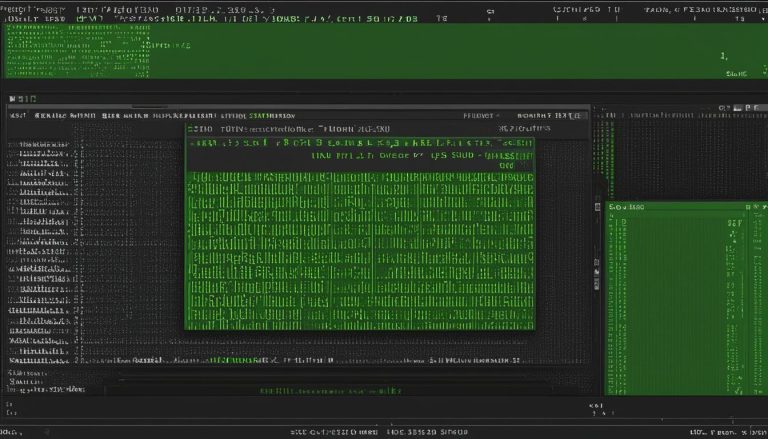YUM (Yellowdog Updater Modified) is an open-source package management tool for RPM-based Linux systems. It allows users to easily install, update, remove, and search for software packages. YUM was developed by Seth Vidal under the GPL license and is widely used in distributions like CentOS, Fedora, and Red Hat. While the yum command has been replaced by the dnf command in newer distributions, YUM remains a crucial tool for simplifying server management.
Key Takeaways:
- YUM is an open-source package management tool for RPM-based Linux systems.
- It allows for easy installation, updating, removal, and searching of software packages.
- YUM was developed by Seth Vidal and is widely used in distributions like CentOS, Fedora, and Red Hat.
- The yum command has been replaced by the dnf command in newer distributions, but YUM still plays a crucial role in server management.
- YUM simplifies the process of managing software updates and ensures system security.
Installing and Removing Packages with YUM
When using YUM (Yellowdog Updater Modified), installing and removing packages on a Linux system becomes a simple and straightforward process. To install a package, you can utilize the yum install [package name] command. YUM will automatically search for and install any necessary dependencies required for the package to function properly.
Removing a package with YUM is just as effortless. By executing the command yum remove [package name], YUM will not only remove the specified package but also eliminate any unnecessary dependencies that are no longer needed after the removal process.
With YUM’s efficient package management capabilities, users can streamline the installation and removal of software packages on their Linux system effortlessly, ensuring a smooth and hassle-free experience.
Updating and Listing Packages with YUM
In order to ensure that your Linux system is up to date and running smoothly, it is essential to regularly update the packages installed on your system. YUM (Yellowdog Updater Modified) provides a convenient and efficient way to update packages with just a few simple commands.
To update a specific package using YUM, you can use the command “yum update [package name]”. This command will check for any updates available for the specified package and install them automatically. YUM will also handle any necessary dependencies, ensuring that all related packages are updated as well.
If you would like to list the available packages on your system, you can use the command “yum list [package name]”. This command will display a comprehensive list of all the packages that match the specified name, including both installed packages and packages available for installation. This can be useful when you want to check if a specific package is already installed on your system or if there are any updates available.
| Command | Description |
|---|---|
| yum update [package name] | Updates the specified package and its dependencies |
| yum list [package name] | Lists all packages that match the specified name |
By regularly updating and listing packages with YUM, you can ensure that your Linux system remains secure and up to date with the latest software releases. Whether you need to update a specific package or simply want to browse the available packages, YUM provides a powerful tool for managing your system’s software.
Searching and Getting Information about Packages with YUM
YUM provides a powerful search function that allows users to find packages based on keywords. With the command “yum search [keyword], you can easily explore the vast array of available packages. Whether you’re looking for a specific software tool or just browsing for something new, YUM’s search feature makes it easy to discover the packages that meet your needs.
Once you’ve found a package that interests you, YUM also allows you to retrieve detailed information about it. By using the command “yum info [package name]”, you can access essential details such as the package version, size, and description. This information is particularly useful when you want to learn more about a package before installing it, ensuring that you have all the necessary information to make an informed decision.
YUM’s search and information retrieval capabilities make it a valuable tool for Linux users and system administrators alike. Whether you’re searching for a specific package or exploring the vast library of available software, YUM puts the information you need right at your fingertips.
Benefits of using YUM for package search and information retrieval
- Efficiency: YUM’s search function quickly scans through the available packages, saving you time and effort.
- Accuracy: The search results provided by YUM are precise, ensuring that you find the packages that match your search criteria.
- Comprehensive Information: YUM’s package info command offers in-depth details, giving you a complete understanding of the package’s features and specifications.
- Improved decision-making: By providing all the necessary information, YUM empowers you to make informed choices when selecting and installing packages.
| Command | Description |
|---|---|
| yum search [keyword] | Search for packages based on a specific keyword |
| yum info [package name] | Retrieve detailed information about a specific package |
Conclusion
YUM, also known as Yellowdog Updater Modified, is an essential tool for Linux package management. As a powerful package manager, it simplifies the process of installing, updating, and removing software packages on RPM-based Linux systems. Whether you’re using CentOS, Fedora, or Red Hat, YUM provides a reliable and efficient way to manage your packages.
With YUM, you can easily install new packages by using the command “yum install [package name]”. It automatically takes care of any dependencies required by the package. Similarly, removing packages is a breeze with the command “yum remove [package name]”. YUM also removes any unnecessary dependencies after the package is removed, ensuring a clean system.
Updating packages with YUM is convenient as well. By using the command “yum update [package name]”, you can easily check for updates and install them. To list all available packages, simply type “yum list [package name]”. This provides a comprehensive overview of the packages that match your search.
Although YUM has been replaced by the dnf command in newer Linux distributions, it remains a crucial tool for many users and system administrators. Its reliability and efficiency make it a staple in the Linux community. So, if you’re looking for a powerful package manager for your RPM-based Linux system, give YUM a try!
FAQ
What is YUM?
YUM (Yellowdog Updater Modified) is an open-source package management tool for RPM-based Linux systems. It allows users to easily install, update, remove, and search for software packages.
Who developed YUM?
YUM was developed by Seth Vidal under the GPL license.
Which Linux distributions use YUM?
YUM is widely used in distributions like CentOS, Fedora, and Red Hat.
Has YUM been replaced by another command?
Yes, the yum command has been replaced by the dnf command in newer distributions. However, YUM remains a crucial tool for simplifying server management.
How do I install a package with YUM?
To install a package, you can use the command “yum install [package name]”. YUM will automatically find and install any required dependencies for the package.
How do I remove a package with YUM?
To remove a package, you can use the command “yum remove [package name]”. YUM will also remove any dependencies that are no longer needed after the package is removed.
How do I update packages with YUM?
You can update packages on your system using the command “yum update [package name]”. This command will check for updates for the specified package and install any available updates.
How do I list available packages with YUM?
You can list the available packages with the command “yum list [package name]”. This will show you all the packages that match the specified name, both installed and available for installation.
How do I search for packages with YUM?
YUM provides a search function that allows you to search for packages based on keywords. You can use the command “yum search [keyword]” to search for packages that match the specified keyword.
How do I get detailed information about a package with YUM?
You can get detailed information about a specific package using the command “yum info [package name]”. This will provide information such as the package version, size, and description.
Why is YUM important for managing software packages on Linux systems?
YUM is a powerful tool that simplifies the process of installing, updating, and removing packages, ensuring that your system is up to date and secure.
Is YUM still relevant even though it has been replaced by the dnf command?
Yes, YUM still remains a crucial tool for many Linux users and system administrators, regardless of the availability of the dnf command. Whether you’re using CentOS, Fedora, or Red Hat, YUM provides a reliable and efficient way to manage your packages.
Hi, I’m Mark, the author of Clever IT Solutions: Mastering Technology for Success. I am passionate about empowering individuals to navigate the ever-changing world of information technology. With years of experience in the industry, I have honed my skills and knowledge to share with you. At Clever IT Solutions, we are dedicated to teaching you how to tackle any IT challenge, helping you stay ahead in today’s digital world. From troubleshooting common issues to mastering complex technologies, I am here to guide you every step of the way. Join me on this journey as we unlock the secrets to IT success.


